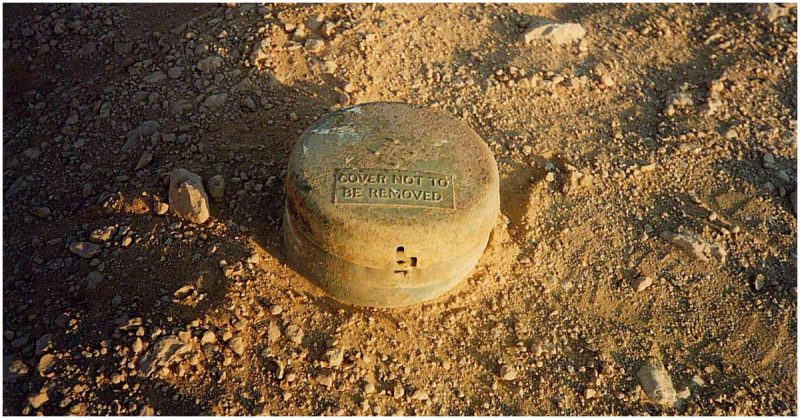The Battle of El Alamein was a critical battle in World War II which heralded the beginning of the end for the Nazi regime. Though the battle was fought 75 years ago, it is still claiming lives today.
Members of the Western Desert Mine Clearance Regiment of the Egyptian military recently demonstrated the work they do to remove the landmines left over from both sides of that battle.
Foreign officials watched as a mine exploded after being detonated by a remote-controlled vehicle. Meanwhile, soldiers used detectors to search for more explosives still buried in the sand.
The battle gave the upper hand to the Allies for the remainder of the war and helped push the Italians and Germans out of North Africa. But for locals on the ground, the event that British leader Winston Churchill famously called the “end of the beginning” of the war has left a threat that remains three-quarters of a century later. Millions of unexploded landmines that are still rusting in the ground.
The European Union has sent $5.5 million (€4.7 million) in recent years to fight the problem after the Egyptian military cut their funding. 1,000 square km (390 square miles) have been cleared, but there are still massive areas remaining.
Ivan Surkos, the ambassador to Egypt from the EU said that there are still 2,680 square km that contain landmines.
The United Nations has offered assistance in the form of education efforts. The visiting dignitaries were given a demonstration at a nearby school. Students read from pamphlets that have been distributed to them and showed off banners warning of the dangers of landmines.
The work seems to be helping. So far in 2017, there has only been one fatality from landmines which is much less than past years, according to General Fathy Mansour who is the deputy commander of the Military Engineering corps.
Workers mark spots with red flags when they find mines. Then the mine is either detonated or defused, depending on what type it is.
Farahat Abdel Atie works maintaining artificial limbs for people who have lost arms or legs from landmine explosions. Atie himself is a victim of the mines, losing part of his leg while grazing his sheep.
Egypt’s ministry of international cooperation stated that the mines are blocking the socio-economic growth of the area which is rich in natural resources.
As evidence that the area can thrive without the mines, a new city has grown in the cleared area. It is part of a government program to create over 30 cities to relieve the pressure from congestion in Egypt’s current cities, according to the UNDP representative in Egypt, Richard Dictus.
The intent is for the new city to boost the economy of the country by providing 300,000 jobs and pulling people out of heavily populated urban areas.
The Allied victory came at approximately the same time as the Soviet victory in Stalingrad. The two battles were the culmination of the war in Europe and Africa. The Germans and Italians were no longer able to put up much of a defense against the surging Allies.
Outnumbered by at least two to one, Field Marshal Erwin Rommel lay in a 40-mile line of landmines to protect against the Allied assault he knew must come. The Allies did not disappoint and made their initial attacks on October 23, 1942. The landmines managed to slow the advance of the Allied tanks, but British commander Bernard Law Montgomery used his numbers advantage to push through the German defenses. He missed an opportunity to capture Rommel’s entire army after breaking through, and Rommel retreated to Tunisia. Even though they escaped, the Germans were out of the Mediterranean by May of 1943.
Still, the landmines remain and they continue to exact a toll in human life to this day.
